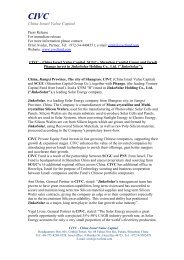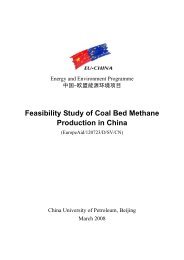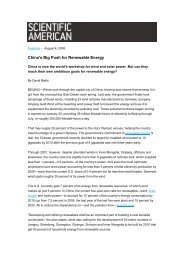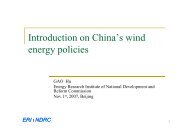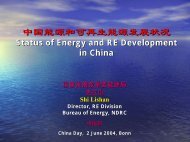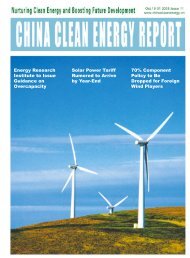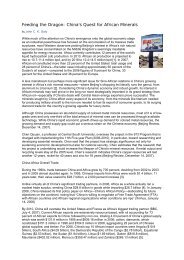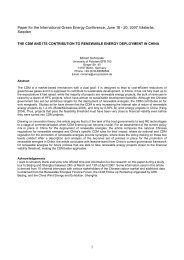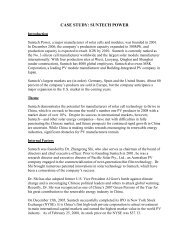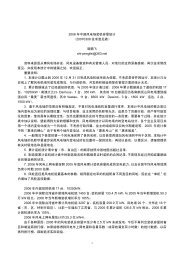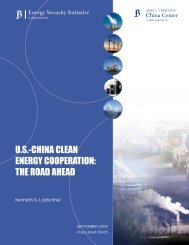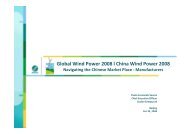LDK Solar Co., Ltd. - Asia Europe Clean Energy (Solar) Advisory Co ...
LDK Solar Co., Ltd. - Asia Europe Clean Energy (Solar) Advisory Co ...
LDK Solar Co., Ltd. - Asia Europe Clean Energy (Solar) Advisory Co ...
You also want an ePaper? Increase the reach of your titles
YUMPU automatically turns print PDFs into web optimized ePapers that Google loves.
Challenges facing the solar power industry<br />
Some of the key challenges faced by the solar power industry include the following:<br />
Possible Reduction or Elimination of Government Subsidies and Incentives. The current growth of the<br />
solar power industry substantially relies on the availability and size of government subsidies and economic<br />
incentives, such as capital cost rebates, reduced tariffs, tax credits, net metering and other incentives.<br />
Governments may eventually decide to reduce or eliminate these subsidies and economic incentives. It<br />
remains a challenge for the solar power industry to reach sufficient scale to be cost-effective in a nonsubsidized<br />
marketplace.<br />
Need to Improve <strong>Co</strong>st <strong>Co</strong>mpetitiveness Against Other <strong>Energy</strong> Sources. The cost of installing a solar<br />
power system may render solar energy more expensive than traditional fossil fuel generated electricity.<br />
Relatively high product costs remain one of the impediments to growth in solar power usage. Manufacturers<br />
must address this by improving the cost efficiency of solar power systems through innovation and continuous<br />
improvement of production techniques.<br />
Supply <strong>Co</strong>nstraint of Polysilicon. Polysilicon is currently in short supply. According to Photon<br />
<strong>Co</strong>nsulting, in 2006, the global demand for photovoltaic modules is expected to exceed that of production by<br />
2.6 gigawatts. Underlying demand will outstrip supply through at least 2008 and likely 2010. Insufficient<br />
supply of polysilicon may hinder the growth of the solar power industry.<br />
Need to Broaden Awareness and Acceptance of <strong>Solar</strong> Power Usage. Growth in solar power usage has<br />
been mostly limited to on-grid applications. <strong>Solar</strong> energy products sales consist substantially of standard solar<br />
modules and systems. Broader market awareness will be required in order to tap the potential of the off-grid<br />
market.<br />
Photovoltaic products manufacturing value chain<br />
<strong>Solar</strong> power systems generally comprise a multitude of solar modules, which are made of multiple solar<br />
cells. There are two main categories of solar cell technology entailing very different production processes:<br />
‚ crystalline wafer-based production technology, and<br />
‚ thin-film production technology.<br />
Crystalline wafer-based technologies accounted for approximately 92% of solar cells produced in 2006,<br />
according to Photon International.<br />
The crystalline silicon-based photovoltaic products manufacturing value chain starts with the processing<br />
of quartz sands to produce metallurgical-grade silicon. This material is further purified to become semiconductor-grade<br />
or solar-grade virgin polysilicon feedstock. Recyclable polysilicon raw materials, which include<br />
tops and tails of discarded portions of polysilicon ingots, pot scraps and broken polysilicon wafers acquired<br />
from the semiconductor and solar power industries, may also be used as feedstock.<br />
In the most widely used crystalline silicon-based solar manufacturing process, feedstock is melted in high<br />
temperature furnaces and is then formed into ingots through a crystallization process. Due to the significant<br />
increase in virgin polysilicon prices, using less virgin polysilicon and more recyclable polysilicon raw materials<br />
to manufacture ingots results in lower overall cost of raw materials. However, the use of recyclable polysilicon<br />
raw materials increases the difficulty of producing ingots with quality similar to those made from virgin<br />
polysilicon. Ingots are cut into blocks and then sliced into wafers using high precision techniques.<br />
Wafers are manufactured into solar cells through a multiple step manufacturing process that entails<br />
etching, doping, coating and applying electrical contacts. <strong>Solar</strong> cells are then interconnected and packaged to<br />
form solar modules, which together with system components such as batteries and inverters, are distributed to<br />
installers, systems integrators, service providers or directly to end-users, for installation onto on-grid or off-grid<br />
systems.<br />
69



